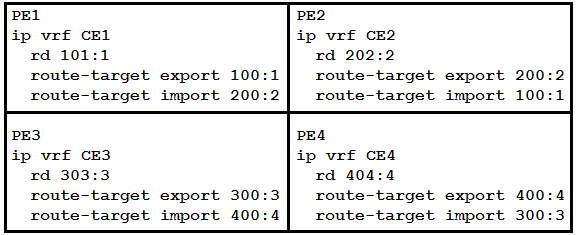Which utility can you use to validate an LSP in an MPLS environment?
- A. uRPF
- B. MPLS LSP ping
- C. logging
- D. RSVP
Answer : B
What is the primary function of a VRF on a router?
- A. It enables the router to support multiple separate routing tables, which allows the device to handle overlapping IP addresses.
- B. It enables a router to run BGP and a distance vector routing protocol at the same time, which allows it to serve as a VPN endpoint between remote sites.
- C. It enables a router to configure VLANs locally, which provides segregation between networks.
- D. It enables the router to provide faster switching through the network by using labels to identify the input and output interfaces for neighbor routers.
Answer : A
Which two statements describe primary differences between MPLS Layer 2 and Layer 3 VPNs? (Choose two.)
- A. Layer 2 VPNs use IPsec tunneling, but Layer 3 VPNs use L2TPv3 tunneling.
- B. Layer 2 VPNs use AToM, but Layer 3 VPNs use MPLS/BGP.
- C. Layer 2 VPNs use BGP, but Layer 3 VPNs use VPLS.
- D. Layer 2 VPNs use L2TPv3 tunneling, but Layer 3 VPNs use GRE tunneling.
- E. Layer 2 VPNs use IPsec tunneling, but Layer 3 VPNs use pseudowires to provide tunneling.
Answer : BD

Refer to the exhibit. A network engineer has been called to configure the four PE devices in order to enable full communication among the four CE devices connected to them. While starting to configure, he experienced a connectivity issue. Which two tasks should the engineer perform in order to begin the process correctly? (Choose two.)
- A. Configure PE3 to export route-targets 100:1 and 200:2.
- B. Configure PE3 to import route-targets 100:1 and 200:2.
- C. Configure PE4 to import route-targets 101:1 and 202:2.
- D. Configure PE2 to export route-targets 300:3 and 400:4.
- E. Configure PE1 to import route-targets 300:3 and 400:4.
Answer : AB

Refer to the exhibit. If the two devices are operating normally, which two conclusions can you draw from this configuration? (Choose two.)
- A. CE1 must use OSPF to establish a neighbor relationship with PE1.
- B. PE1 labels the routes it learns from CE1 with the route-target 222:2 and shares them with its VPNv4 peers.
- C. PE1 labels the routes it learns from CE1 with the route-target 111:1 and shares them with its VPNv4 peers.
- D. The PE-CE routes between the devices are being exchanged by OSPF
- E. CE1 is supporting CSC.
Answer : AD

